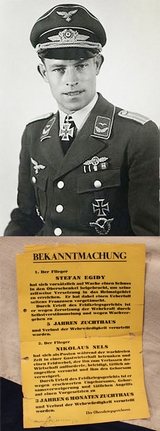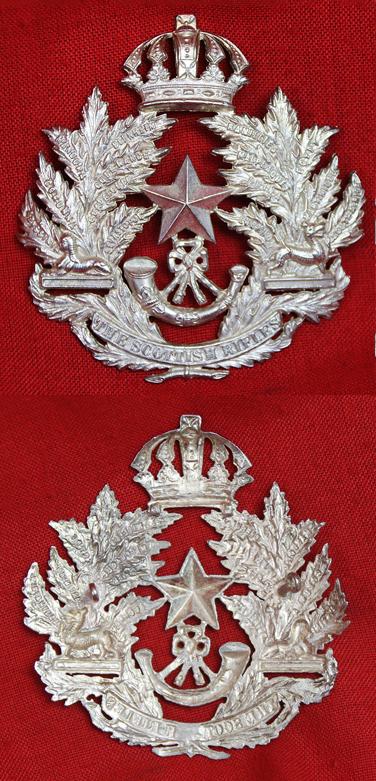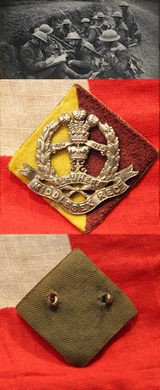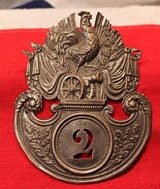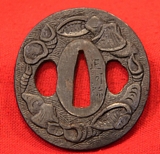Fascinating German WW2 Public Notice Poster Regarding Two Luftwaffe Flyers. Public Crucifixion of Former Luftwaffe Fighting Aces. Blamed For The Loss of The Battleship Tirpitz
Der flieger [flyer] Stefan Egidy hat sich vorsatzlich auf wache einen schuss in den oberschenkel beigebracht, um seine zeitweise versetzung in das helmatgeblet zu erreichen .er hat dabel einen ueberfall seitens franzosen vorgetauscht durch urtell des feldkriegsgerichts ist er wegen zerstzung der wehrkraft durch selbstverstummelung und wegen wachvergehen zu 5 jahren zucthaus und verlust der wehrwurdigkeit verurteilt worden. Roughly it translates that Flyer Stefan Egidy was court martialled for a self inflicted wounding and sentence to 5 years and loss of privileges. Also Flieger [flyer] Niklaus Nels was similar court-martialled and sentenced to 3 years 6 months. German pilots were occasionally court-martialled for all manner of reasons, another one at the time was Born in Oberbalbach, Heinrich Ehrler, he grew up in the Weimar Republic and Third Reich as one of 12 children. He joined the military service in the Wehrmacht in 1935, initially service with the artillery and anti-aircraft artillery. He participated in the Spanish Civil War and following the outbreak of World War II transferred to the Jagdwaffe (fighter force). Following flight training, he was posted to the 4. Staffel of Jagdgeschwader 77 (JG 77?77th Fighter Wing), which was later redesignated to 4. Staffel of Jagdgeschwader 5 (JG 5?5th Fighter Wing).
Scapegoated for the loss of the German battleship Tirpitz, Ehrler - who had been nominated for the Knight's Cross of the Iron Cross with Oak Leaves and Swords prior to the disaster - was court-martialled, stripped of his command and sentenced to three years and two months Festungshaft (honorable imprisonment). Ehrler's sentence was later commuted and his loss of rank rescinded, and in February 1945 he was transferred to Jagdgeschwader 7. According to his fellow pilots, Ehrler thereafter flew in the increasingly desperate air battles without the purpose and dedication that had made him one of the Luftwaffe's most successful aces. On 4 April 1945, he shot down two Allied bombers for his final two victories, before destroying a third by ramming with his damaged aircraft after having run out of ammunition. His last recorded statement was "Theo, I have run out of ammunition. I'm going to ram this one. Good bye. We'll see each other in Valhalla." - Heinrich Ehrler's last transmission over the Squadron Radio Network before he rammed the B-24 bomber "Trouble in Mind," piloted by Captain John Ray, destroying both aircraft and killing himself. Central tear through middle can't be seen in photo
Intriguing ephemera from the 3rd Reich would look very fine if framed, obviously not in good condition but as direct examples of WW2 aeronautical history absolutely fascinating. Remarkable to survive and probably unique examples. read more
135.00 GBP
A Very Good Steel 'Belted Bullet' Mould Marked 14 and WD (William Davies)
A rare collectable for a 19th century 'two-groove' British rifle, such as the Brunswick. Cavity measures .750" at the bottom of the grooves, with approx .70” ball. This mould casts a spherical ball with bands for two-groove rifling. stamped by maker W.D. William Davies who was one of England's best bullet mould makers in the reign of King George in England, and later during the early part of Victoria's reign. This mould is in excellent plus condition.
The rifle with belted ball two-groove rifling that was at the pinnacle of rifle development in the 1830s and 1840s. With multi-groove rifling it was difficult to ram the ball down particularly if the barrel was fouled up and often a hammer had to be carried to belt down the ramrod.
With a belted ball, a belt was created around the bullet and two corresponding deep grooves were cut in the barrel. The ball was carefully located in these grooves and it could be easily pushed down. Since the two-groove rifling was deep cut, there was no possibility of the bullet stripping and quite high charges could be used. Belted ball rifles tended to be in the bigger calibres as they were too tricky to load in smaller calibres.
Overall length 7.5" read more
325.00 GBP
A Most Interesting Late Edo Japanese Gilt Lacquer Wooden Sword and Samurai Artifact Folding Display Stand. Decorated with Hand Painted Cranes and Bamboo
A folding wood and hand painted lacquer sword rack display stand, for the display of three samurai swords and for the area beneath for the decoration of samurai artefacts such as sword fittngs, mempo, abumi, war fans, or, such as beautiful Japanese tea ceremony pieces, early iron water vessels, and tea bowls etc.
See a selection of items shown for illustrative purposes.
Signed by the artist on both the obverse and reverse side. The hand painted cranes and bamboo are on fine gold leaf covered panels, and show considerable age wear, but this enhances its air of contrived antiquity for the display of early samurai swords, weaponry and artefacts
It has long been the tradition of areas of Japanese art to make for display late Edo pieces, in the much earlier ancient forms and styles. Such as, for example, russetted Higo style iron sword mounts. Actually made in the 18th century, but made to appear as they were ancient iron pieces from many centuries before. In many respects as an homage to much revered ancient Japanese art forms read more
1425.00 GBP
The Scottish Rifles, Helmet Plate, With Battle Honours, Silvered
In jolly nice condition, die cast, two lugs 10cm x 9.5cm.
The Cameronians (Scottish Rifles) was a rifle regiment of the British Army, the only regiment of rifles amongst the Scottish regiments of infantry. It was formed in 1881 under the Childers Reforms by the amalgamation of the 26th Cameronian Regiment and the 90th Perthshire Light Infantry. In 1968, when reductions were required, the regiment chose to be disbanded rather than amalgamated with another regiment, one of only two infantry regiments in the British Army to do so, with the other being the York and Lancaster Regiment. It can trace its roots to that of the Cameronians, later the 26th of Foot, who were raised in 1689. The 1881 amalgamation coincided with the Cameronian's selection to become the new Scottish Rifles.
The regiment's battle honours included:
Early wars: Blenheim, Ramillies, Oudenarde, Malplaquet, South Africa 1846-72, South Africa 1877-8-92, Relief of Ladysmith, South Africa 1899-1902
The Great War: Mons, Le Cateau, Retreat from Mons, Marne 1914 '18, Aisne 1914, La Bassée 1914, Messines 1914, Armentières 1914, Neuve Chapelle, Aubers, Loos, Somme 1916 '18, Albert 1916, Bazentin, Pozières, Flers-Courcelette, Le Transloy, Ancre Heights, Arras 1917 '18, Scarpe 1917 '18, Arleux, Ypres 1917 '18, Pilckem, Langemarck 1917, Menin Road, Polygon Wood, Passchendaele, St Quentin, Rosières, Avre, Lys, Hazebrouck, Bailleul, Kemmel, Scherpenberg, Soissonnais-Ourcq, Drocourt-Quéant, Hindenberg Line, Épéhy, Canal du Nord, St Quentin Canal, Cambrai 1918, Courtrai, Selle, Sambre, France and Flanders 1914-18, Doiran 1917 '18, Macedonia 1915-18, Gallipoli 1915-16, Rumani, Egypt 1916-17, Gaza, El Mughar, Nebi Samwil, Jaffa, Palestine 1917-18
Second World War: Ypres-Comines Canal, Odon, Cheux, Caen, Mont Pincon, Estry, Nederrijn, Best, Scheldt, South Beveland, Walcheren Causeway, Asten, Roer, Rhineland, Reichswald, Moyland, Rhine, Dreierwalde, Bremen, Artlenberg, North-West Europe 1940, '44-45, Landing in Sicily, Simeto Bridgehead, Sicily 1943, Garigliano Crossing, Anzio, Advance to Tiber, Italy 1943-44, Pegu 1942, Paungde, Yenagyaung 1942, Chindits 1944, Burma 1942 '44.
Silver coloured metal, not hallmarked read more
95.00 GBP
Royal Gurkha Rifles, Pouch Belt Badge & Plate - Silver Plate "Come and fight a Gurkha!" Gurkha Lachhiman Gurung VC Who Single Handedly Fought Off & Beat 200 Japanese With One Hand Blown Off & Blinded in 1 Eye By Grenade
Considered to be one of the greatest and bravest regiments in the world. The very finest men to fight alongside, and the very, very worst to fight against.
"Ayo Gorkali" the battle cry of the Gurkhas, "The Gurkhas Are Coming", has been known to instill terror in any confronted enemy of the Gurkhas. Many battle hardened Japanese infantrymen in WW2, and Argentinian soldiers in The Falklands were known to have run and fled or surrendered immediately upon that battle cry being heard.
The Royal Gurkha Rifles (RGR) is a rifle regiment of the British Army, forming part of the Brigade of Gurkhas. Unlike other regiments in the British Army, RGR soldiers are recruited from Nepal, which is neither a dependent territory of the United Kingdom nor a member of the Commonwealth.
Just one example of Gurkha heroism is Corporal Dip Prasad Pun of the 1st battalion (1 RGR) was awarded the Conspicuous Gallantry Cross for an act of bravery during the War in Afghanistan in 2010. He alone defended his outpost against a force of up to 12 Taliban fighters. He fired more than 400 rounds, 17 grenades, and one mine. He resorted to fighting with his machine gun tripod after his ammunition had run out
The battle honours of the Royal Gurkha Rifles are as follows:29
Amboor, Carnatic, Mysore 1792, Assaye 1803, Ava 1852, Burma 1885–87, Bhurtpore, Aliwal, Sobraon, Delhi 1857, Kabul 1879, Afghanistan 1878–80, Kandahar 1880, Tirah, Punjab Frontier, Afghanistan 1919
First World War: La Bassée 1914, Festubert 1914–15, Givenchy 1914, Neuve Chapelle, Aubers, Loos, France and Flanders 1914–15, Egypt 1915, Tigris 1916, Kut al Amara 1917, Baghdad, Mesopotamia 1916–18, Persia 1918, Baluchistan 1918, Helles, Krithia, Suvla, Sari Bair, Gallipoli 1915, Suez Canal, Egypt 1915–16, Khan Baghdadi, Mesopotamia 1916–18, Persia 1916–1918, North West Frontier India 1915–17, Egypt 1915, Megiddo, Sharon, Palestine 1918, Shaiba, Kut al Amara 1915–17, Ctesiphon, Defence of Kut al Amara, Baghdad, Sharqat, Mesopotamia 1915–18
The Second World War: Tobruk 1942, El Alamein, Akarit, Tunis, Cassino 1, Poggio Del Grillo, Gothic Line, Tavoleto, Coriano, Santacangelo, Monte Chicco, Bologna, Medicina, Italy 1944-45, Jitra, Slim River, Sittang 1942, 1945, Kyaukse 1942, 1945, North Arakan, Imphal, Tuitum, Bishenpur, Tengnoupal, Shwebo, Kyaukmyaung Bridgehead, Mandalay, Myinmu Bridgehead, Fort Dufferin, Meiktila, Irrawaddy, Rangoon Road, Chindits 1943,44 & 45, Tamandu, Maymyo
Falklands War.
Picture 8 in the gallery is of Jemadar Jangia Bullets Thapa, 5th Gurkha Regiment, 1890
One of Major-General Frederick Roberts's orderlies during the 2nd Afghan War (1878-1880), Jemadar Jangia Thapa was nicknamed 'Bullets' because regimental tradition had it that he had once been hit on the forehead by a bullet which had been completely flattened without causing him the least discomfort. Thapa was admitted to the Second Class of the Order of British India in April 1897 and was selected as one of the representatives for India at the inauguration of the Australian Commonwealth in January 1901.
One of the most famous Gurkhas in the British Army
Lachhiman Gurung VC ( 30 December 1917 – 12 December 2010) was a Nepalese–British Gurkha recipient of the Victoria Cross, the highest and most prestigious award for gallantry in the face of the enemy that can be awarded to British and Commonwealth forces. He is best known as the "Gurkha who took on 200 soldiers with only one hand" because of his actions in World War II.
On 12/13 May 1945 at Taungdaw, Burma now Myanmar, Rifleman Lachhiman Gurung was manning the most forward post of his platoon which bore the brunt of an attack by at least 200 of the Japanese enemy. He hurled back two hand grenades which had fallen on his trench, but the third exploded in his right hand after he attempted to throw it back, blowing off his fingers, shattering his arm and severely wounding him in the face, body and right leg. His two comrades were also badly wounded but the rifleman, now alone and disregarding his wounds, loaded and fired his rifle with his left hand for four hours (all while he screamed "Come and fight a Gurkha!"), calmly waiting for each attack which he met with fire at point blank range.
His citation in the London Gazette ends with...
...Of the 87 enemy dead counted in the immediate vicinity of the Company locality, 31 lay in front of this Rifleman's section, the key to the whole position. Had the enemy succeeded in over-running and occupying Rifleman Lachhiman Gurung's trench, the whole of the reverse slope position would have been completely dominated and turned.
This Rifleman, by his magnificent example, so inspired his comrades to resist the enemy to the last, that, although surrounded and cut off for three days and two nights, they held and smashed every attack.
His outstanding gallantry and extreme devotion to duty, in the face of almost overwhelming odds, were the main factors in the defeat of the enemy.1
He received his Victoria Cross from the Viceroy of India, Field Marshal Lord Wavell at the Red Fort in Delhi on 19 December 1945
Four threaded mounting screw posts, with two affixing rounded nuts present.
93mm x 75mm read more
140.00 GBP
A Most Scarce Third Reich Period Deutche Luftfahrt/DLV Officer's Visor Cap Insignia, German Flyers Associoation
DLV (German Flyers Association). The German Air Sports Association (Deutscher Luftsportverband, or DLV e. V.) was an organisation set up by the Nazi Party in March 1933 to establish a uniform basis for the training of military pilots. Its chairman was Hermann Göring and its vice-chairman Ernst Röhm. Since the Treaty of Versailles officially forbade Germany from building fighter planes of any sort, the German Air Sports Association used gliders to train men still officially civilians for the future Luftwaffe. The first steps towards the Luftwaffe's formation were undertaken just months after Adolf Hitler came to power. Hermann Göring, a World War I ace with 22 victories and the holder of the Orden Pour le Mérite, became National Kommissar for aviation with former Deutsche Luft Hansa director Erhard Milch as his deputy. On 25 March 1933 the German Air Sports Association absorbed all private and national organizations, whilst retaining its 'sports' title. In April 1933 the Reichsluftfahrtministerium (RLM – Reich Air Ministry) was established. The RLM was in charge of development and production of aircraft, and soon afterwards the test site or Erprobungsstelle at Rechlin became its testing ground, a military airfield that had been first established in August 1918. Göring's control over all aspects of aviation became absolute.
The German Air Sports Association was dissolved in 1937 and replaced with the National Socialist Flyers Corps, a corporation under public law and subordinate to Reichsluftfahrtminister Göring. read more
140.00 GBP
WW1 Middlesex Regt. Officer's Silver Cap Badge, With Rare Battalion Battle Patch
The battalion battle patch, is a very rare surviving piece of divisional command identification, here, it is set mounted behind the silver badge, as the colour designation of the regiment, and in WW1 it was often used thus so on the tropical helmet with the helmet badge together, it could also be sown separately on the uniform as a patch, with the silver badge affixed as usual on the cap, and it is very rare to see complete, the patch with its silver officer’s badge.
On the Brodie helmet it would be added as a painted regimental badge for identification.
The 1st Battalion landed at Le Havre, as line of communication troops, in August 1914 for service on the Western Front.
Lieutenant-Colonel John Hamilton Hall (standing directly in front of the Red Cross on the ambulance), the CO of the 1st Battalion, Middlesex Regiment (98th Brigade, 33rd Division), with his officers. Photograph taken during the battalion's rest near Cassel, 25 April 1918.
The 2nd Battalion landed at Le Havre as part of the 23rd Brigade in the 8th Division in November 1914 also for service on the Western Front.[18]
The 3rd Battalion landed at Le Havre aspart of the 85th Brigade in the 28th Division in January 1915 for service on the Western Front before moving to Egypt in October 1915 and to Salonika in December 1915.
The 4th Battalion land at Boulogne-sur-Mer as part of the 8th Brigade in 3rd Division in August 1914 for service on the Western Front. Some 400 men of the 4th Battalion were killed at the Battle of Mons later that month read more
165.00 GBP
A French 1830's Belltop Shako Helmet Plate 2nd Regiment
Louis Philippe I (6 October 1773 - 26 August 1850) was King of the French from 1830 to 1848 as the leader of the Orleanist party. As a member of the cadet branch of the Royal House of France and a cousin of King Louis XVI of France by reason of his descent from their common ancestors Louis XIII and Louis XIV of France, he had earlier found it necessary to flee France during the period of the French Revolution in order to avoid imprisonment and execution, a fate that actually befell his father Louis Philippe II, Duke of Orleans. He spent 21 years in exile after he left France in 1793. He was proclaimed king in 1830 after his cousin Charles X was forced to abdicate in the wake of the events of the July Revolution of that year. His government, known as the July Monarchy, was dominated by members of a wealthy French elite and numerous former Napoleonic officials. He followed conservative policies, especially under the influence of the French statesman Francois Guizot during the period 1840-48. He also promoted friendship with Britain and sponsored colonial expansion, notably the conquest of Algeria. His popularity faded as economic conditions in France deteriorated in 1847, and he was forced to abdicate after the outbreak of the French Revolution of 1848. He lived out his life in exile in Great Britain. read more
125.00 GBP
A Victorian, Stilleto Style, So-Called Prostitute’s Dagger
With very attractive pressed ivorine handle made to simulate ivory. A prostitutes dagger was so called due to their attractiveness and useful size for concealment by unaccompanied ladies abroad after dark. Of course they would never have been sold as such by retailers, and the term has entered the vernacular of collectors probably even after the time they were actually made, however, like the term 'mortuary hilted swords' that bore the engraved visage of the king in the hilt from the English Civil War, they were never actually called that until almost 200 years later. They are attractively designed elegant daggers, just such as this one, with a slender and most efficient blade. Prostitution became a major concern and a focal point for social reformers in the 19th century. Concerns were seen everywhere including the literature of notables such as Charles Dickens. He created characters (some of which may have had real life versions) like Nancy in Oliver Twist, and Martha Endell in David Copperfield.
No one knows for certain, but there were somewhere between 8,000 and 80,000 prostitutes in London during the Victorian Age. It is generally accepted that most of these women found themselves in prostitution due to economic necessity.
There were three attitudes towards prostitution – condemnation, regulation, and reformation. Dickens adopted the last and was intimately involved in a house of reform called Urania Cottage. No scabbard Blade 4.25 inches, overall 8.25 inches long read more
275.00 GBP
A Good Antique Edo Period Round Signed Tetsu Wakazashi Tsuba Embossed Seashells
A delightful iron round tsuba takebori patterned with various shells over a water pattern background, with ana openings for kozuka and kogai. The Tsuba can be solid, semi pierced of fully pierced, with an overall perforated design, but it always a central opening which narrows at its peak for the blade to fit within. It often can have openings for the kozuka and kogai to pass through, and these openings can also often be filled with metal to seal them closed. For the Samurai, it also functioned as an article of distinction, as his sole personal ornament 61 mm read more
225.00 GBP


